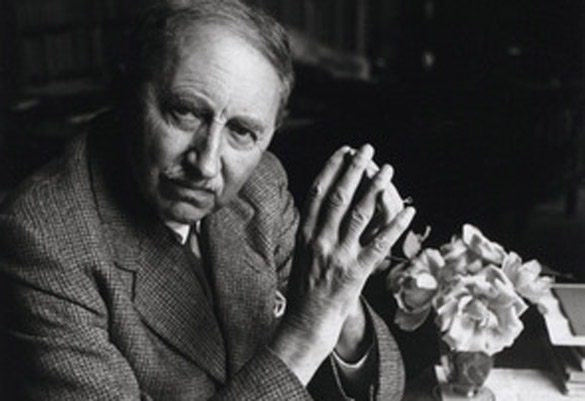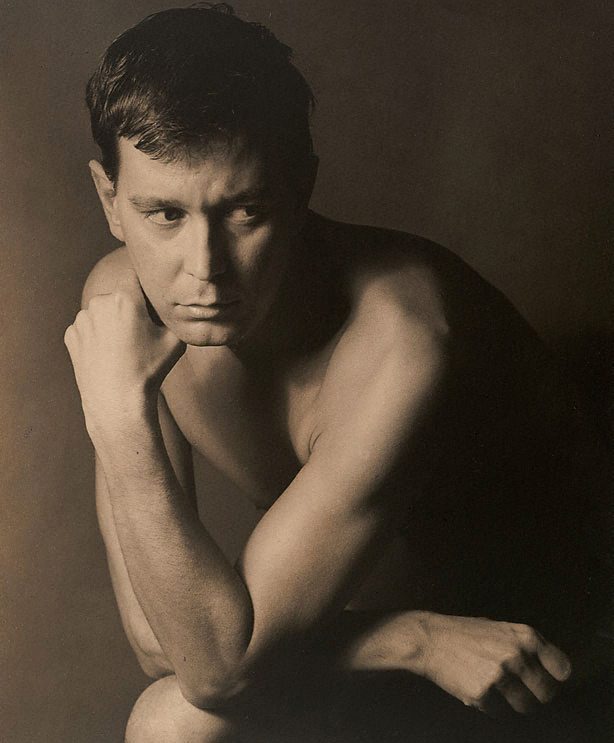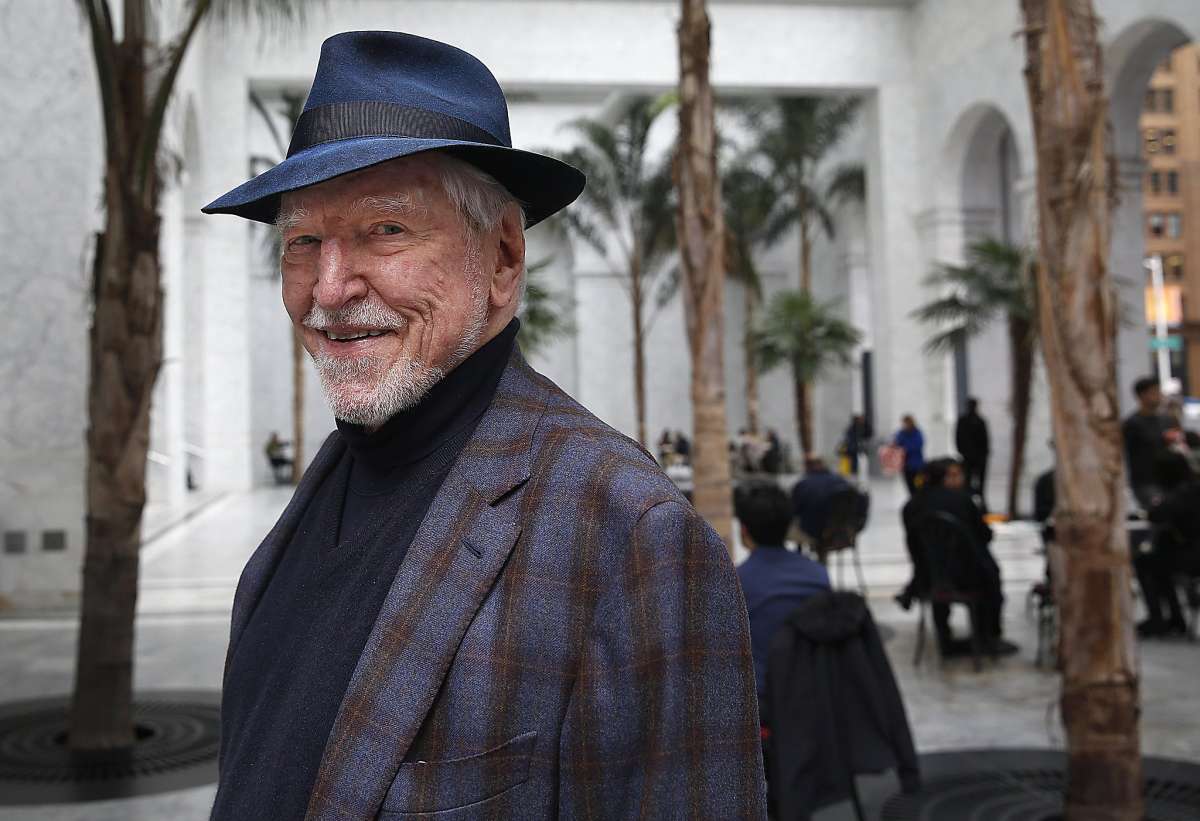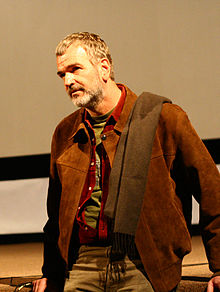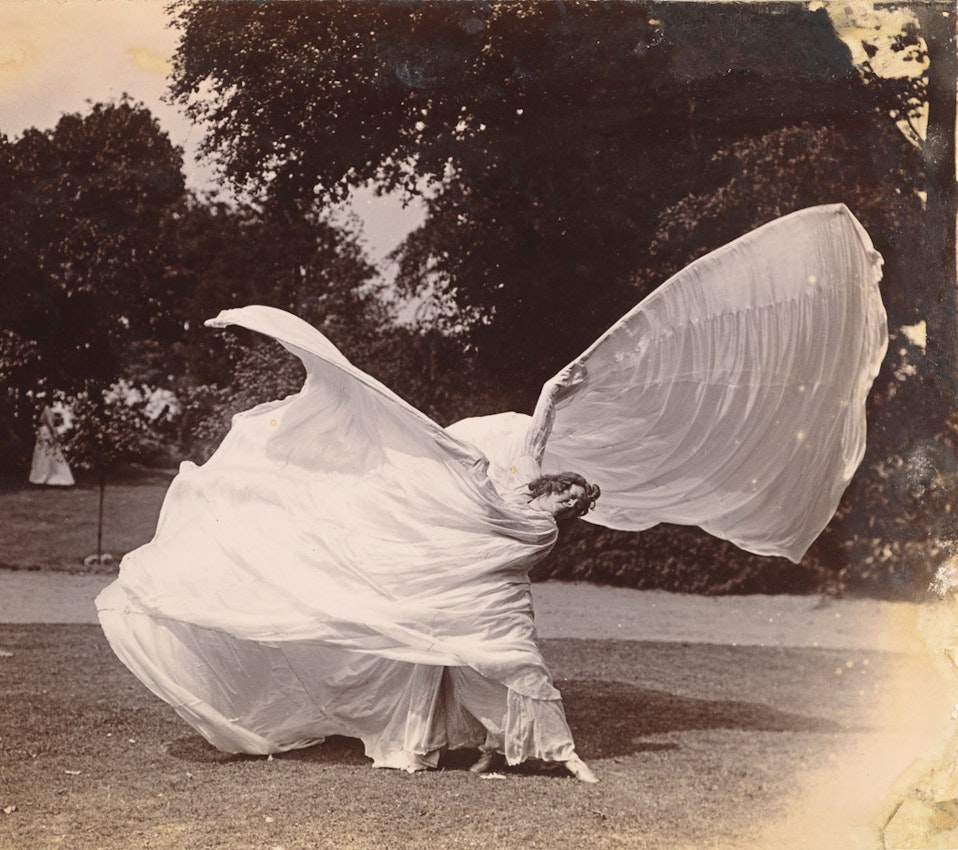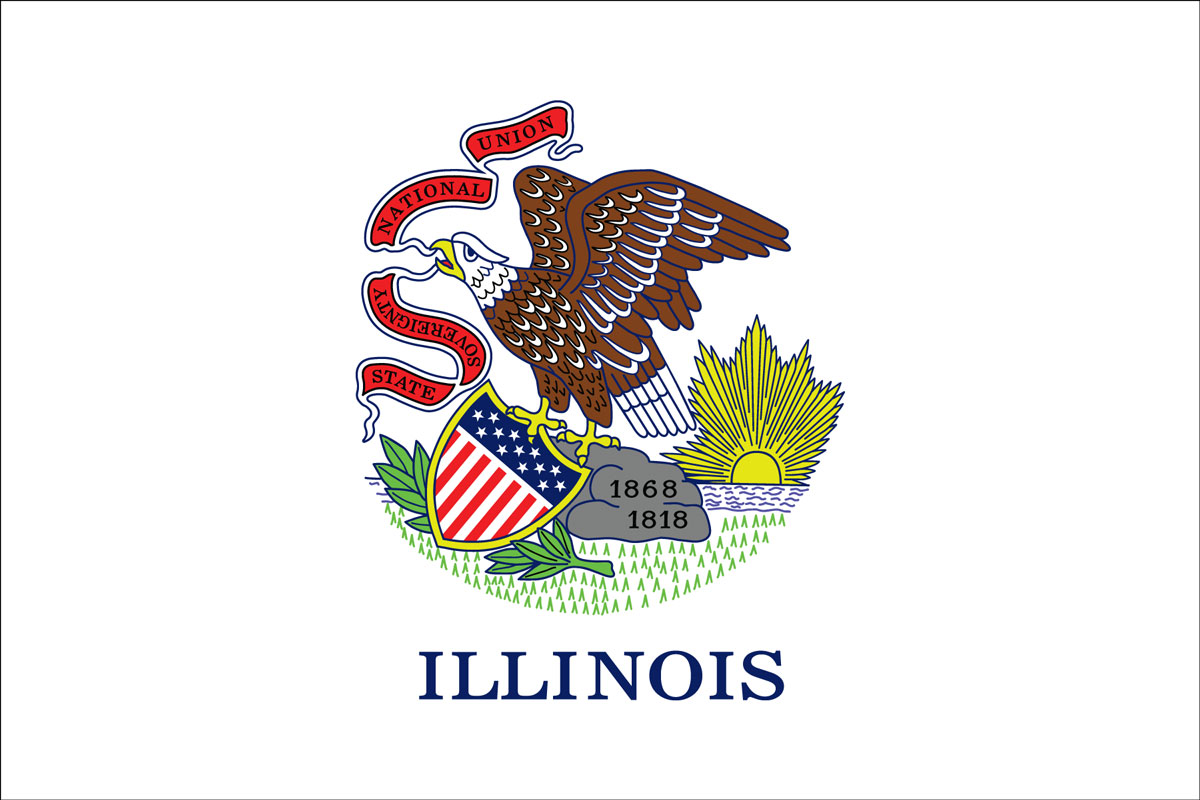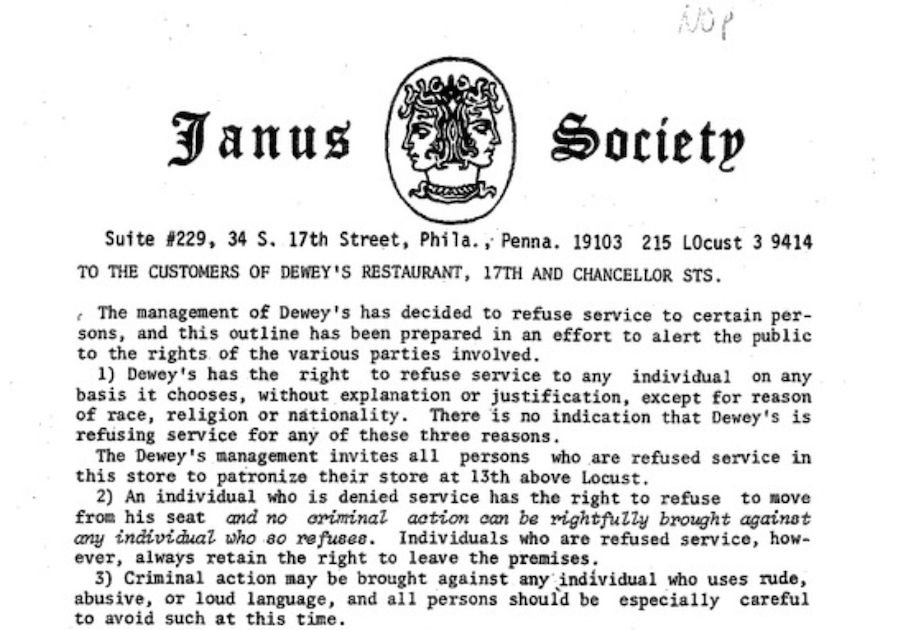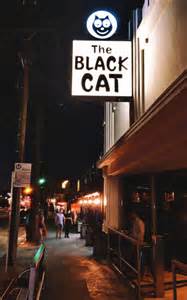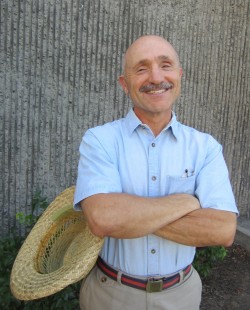January 01
Birth of E.M. FORSTER (d: 1970) Edward Morgan Forster, OM, was an English novelist, short story writer, and essayist. He is known best for his ironic and well-plotted novels examining class difference and hypocrisy in early 20th-century British society. Forster's humanistic impulse toward understanding and sympathy may be aptly summed up in the epigraph to his 1910 novel Howards End: "Only connect". Forster was homosexual, but this fact was not widely made public during his lifetime.
His posthumously-published novel Maurice tells of the coming of age of an explicitly homosexual male character. It was made into a lovely film starring James Wilby, Hugh Grant and Rupert Graves, with a ravishing final scene. This writer swoons every time.
JOE ORTON the British playwright of What the Butler Saw was born on this date (d: 1969); "I have high hopes of dying in my prime," Joe Orton confided to his diary in July 1967, when he was only 34 years old. Less than one month later, Britain's most promising comic playwright was murdered by his lover, Kenneth Halliwell, in the London flat they had shared for fifteen years.
By then, Orton had already attracted a coterie with his outrageous black farces, notably Entertaining Mr. Sloane (1964) and Loot (1966), both of them savagely comic expressions of his contempt for social institutions (in classic Gay archetypal form as the contrary, the jester and the fool) as well as his delight in shocking people.
His twitting of authority first came into public view when he and Halliwell were arrested for having mutilated, and then pasted pornography in over 200 library books. His ensuing six months prison sentence confirmed his conviction that a mere façade covers the hypocrisy (a note here about the recurring "hypocrisy" theme here, on the turning of the year, on a month named for the two-faced Roman god Janus…coincidence?) and viciousness of the police, as well as those of the Church and most other social institutions, including sex – in and out of the marriage bed.
Orton's life with Halliwell was very much a Gay version of A Star is Born, with Halliwell the struggling, unpublished writer fading into obscurity as his wildly promiscuous (another note: the definition of "promiscuous"? "Anyone who has more sex than you do."…if that isn't Orton, it should be) lover became famous.
A few months before Halliwell bashed in Orton's skull with a hammer and then killed himself, Orton had reflected in his diary on having allowed a one-night stand to mount and enter him: "It was a most unappetizing position for an internationally-known playwright to be in." When, two months later, his body was found, it was lying ass-up in a pool of blood.
JAMES CATHERWOOD HORMEL, born on this date (d: 2021), was an American philanthropist LGBT activist, diplomat, and heir to the Hormel meatpacking fortune. He served as the United States Ambassador to Luxembourg from 1999 to 2001, and was the first openly gay man to represent the United States as an ambassador.
Hormel was born in Austin, Minnesota. He is the grandson of George A. Hormel, founder of Hormel Foods. Hormel is the son of Germaine Dubois and Jay Catherwood Hormel, who served as president of Hormel Foods. Hormel earned a Bachelor of Arts degree in history from Swarthmore College and a Juris Doctor from the University of Chicago Law School. After law school, Hormel served as the dean of students and director of admissions at the University of Chicago Law School.
In 1994, President Bill Clinton considered Hormel for the ambassadorship to Fiji, but did not put the nomination forward due to objections from Fijian government officials. At the time, gay male sexual acts were punishable with prison sentences in Fiji and Hormel's being open about his sexuality would stand in conflict with "Fijian culture". Instead Hormel was named as part of the United Nations delegation from the United States to the Human Rights Commission in 1995, and in 1996 became an alternate for the United Nations General Assembly.
In October 1997 Clinton nominated Hormel to be ambassador to Luxembourg, which had removed laws prohibiting consensual same-sex acts between adults in the 1800s. This appointment was the first nomination or appointment of an openly LGBT person from the United States. The Senate Foreign Relations Committee approved his nomination with only Republican and conservative Senators Jesse Helms and John Ashcroft opposed. While his confirmation by the senate initially seemed certain, with only two senators—Tim Hutchinson and James Inhofe—opposing the nomination, subsequent revelations about Hormel's background led to more opposition from Republican senators, leaving Hormel's nomination in limbo. Among the points of contention were:
- The James C. Hormel Gay and Lesbian Center at the San Francisco Public Library, which Hormel funded, was found to contain pornographic materials and documents published by the pro-pedophilia advocacy group NAMBLA. Christian-based conservative groups like the Traditional Values Coalition (TVC) and the Family Research Council (FRC) labelled Hormel as being pro-pornography, asserting that Hormel would be rejected in the largely Roman Catholic Luxembourg. It was later observed that much of the same material could also be found in the Library of Congress.
- The FRC distributed video tapes of a television interview with Hormel at the 1996 San Francisco Pride parade in which Hormel laughed at a joke about the Sisters of Perpetual Indulgence, a group of men who dress in drag as nuns "to mock religious conventions," as they passed by. The Catholic League took this as an indication of approval of what they characterized as an anti-Catholic group. In a meeting with Tim Hutchinson, Hormel declined to repudiate the Sisters. In an interview years later, Hormel objected to the idea that the video clip showed that he approved of the group and that he was anti-Catholic.
- It was revealed that Hormel had contributed $12,000 to fund the production of It's Elementary: Talking About Gay Issues in School, a video aimed at teaching tolerance of homosexuality to grade-school students. This especially inflamed Senator Bob Smith of New Hampshire, who was portrayed unflatteringly in the film. Smith contended that he opposed Hormel not because he was gay but because of his "advocacy of the gay lifestyle".
Trent Lott, the Republican majority leader, worked to block the vote and publicly called homosexuality a sin and compared it to alcoholism and kleptomania.
Concerns about Hormel's reception in Luxembourg were "blunted when officials of the country, which has laws against discrimination based on sexual orientation, indicated that he would be welcome." Senator Alfonse D'Amato of New York found the obstruction of the nomination an embarrassment and urged that Trent Lott bring the issue up for a vote. When Lott continued to stall, Clinton employed a recess appointment on June 4, 1999. Hormel was sworn in as ambassador in June 1999. His partner at the time, Timothy Wu, held the Bible during the ceremony. Also in attendance were Hormel's former wife, his five children, and several of his grandchildren. The treatment of his nomination was referenced by Pete Buttigieg during his acceptance speech for his nomination as Secretary of the Department of Transportation on December 16, 2020.
In 1981, he was one of the founders of the Human Rights Campaign. He was a member of the boards of directors of the San Francisco Chamber of Commerce and the American Foundation for AIDS Research. Hormel contributed $500,000 to fund the creation of the James C. Hormel Gay & Lesbian Center at the San Francisco Public Library in 1996 (renamed the James C. Hormel LGBTQIA Center in 2016).
Hormel participated in numerous events, including a conference organized in 2004 by Amnesty International in the frame of the Geneva Gay Pride. In 2010 he was given the Lifetime Achievement Grand Marshal Award by San Francisco Pride Board of Directors for his LGBT activism over several decades.
Hormel was married to Alice Turner, now a retired psychologist, for ten years before coming out of the closet. He had five children, fourteen grandchildren, and five great-grandchildren. He lived in San Francisco, California, with his spouse Michael Peter Nguyen Araque. James Hormel died in San Francisco on August 13, 2021, at the age of 88.
WIELAND SPECK is a German film director born on this date, who since 1992 has coordinated "Panorama" at the International Filmfestival Berlin (Berlinale). Panorama showcases new films by established directors, as well as debut works by up-and-coming talents.
Since 1972, he started living in Berlin. He studied German, Theater and Ethnology at the Free University of Berlin. Since the mid-1970s, Speck has been engaged in various areas of film and video as well as author and publisher.
In the late 1970s, he was managing director of the Tali-Kino, an independent arthouse cinema in Berlin-Kreuzberg (later called "Moviemento"). From 1979 to 1981 he completed a film study at the San Francisco Art Institute.
Between 1982 and 1992 Speck worked with the German film director Manfred Salzgeber producing LGBT-themed films and shorts. He is the co-creator of the Teddy Award, (with Manfred Salzgeber) which since 1987 was awarded to LGBT films at the Berlinale.
Out gay, he has lived in Berlin since 1972. Speck studied German, theater and ethnology at the Freie Universität Berlin. In 1985, he produced his first feature film Westler. He was a panel member of the Berlin State Film Fund (1990-1993) and the Hamburg Film Fund (1994-1998) and from 1992 to 2017 he was head of the Panorama section of the Berlinale. In 2011 he won the Nino Gennaro Award at the first edition of Sicilia Queer filmfest. In 2015, Speck won the 20th Busan International Film Festival, Korean Cinema Award.
LOIE FULLER born Marie Louise Fuller died on this date (b: 1862); also known as Louie Fuller and Loïe Fuller, Fuller was an American dancer who was a pioneer of both modern dance and theatrical lighting techniques
Born in the Chicago suburb of Fullersburg, Illinois, now Hinsdale, Illinois, Fuller began her theatrical career as a professional child actress and later choreographed and performed dances in burlesque (as a skirt dancer), vaudeville, and circus shows. Her debut took place when she was four years. An early free dance practitioner, Fuller developed her own natural movement and improvisation techniques. In multiple shows she experimented with a long skirt, choreographing its movements and playing with the ways it could reflect light. By 1891, Fuller combined her choreography with silk costumes illuminated by multi-coloured lighting of her own design, and created the Serpentine Dance.
After much difficulty finding someone willing to produce her work when she was primarily known as an actress, she was finally hired to perform her piece between acts of a comedy entitled Uncle Celestine, and received rave reviews.
A regular performer at the Folies Bergère with works such as Fire Dance, Fuller became the embodiment of the Art Nouveau movement and was often identified with symbolism, as her work was seen as the perfect reciprocity between idea and symbol. Fuller began adapting and expanding her costume and lighting, so that they became the principal element in her performance—perhaps even more important than the actual choreography, especially as the length of the skirt was increased and became the central focus, while the body became mostly hidden within the depths of the fabric.
An 1896 film of the Serpentine Dance by the pioneering film-makers Auguste and Louis Lumière gives a hint of what her performance was like. (The unknown dancer in the film is often mistakenly identified as Fuller herself; however, there is no actual film footage of Fuller dancing.)
Her modernism weaves itself into her queerness, which she discovered and embraced first in Paris. Loïe’s very introduction to the city, fleeing an unhappy marriage which seems to have been no more than a failed attempt at “fitting in”, started with a first lesbian relation with the painter Louise Abbéma, who was also, allegedly, Sarah Bernhardt’s former lover. She introduced her to a buzzing sapphic socialite scene, notably the circle of friends of Nathalie Barney, American lesbian poet extraordinaire, who assembled around her a clique of fabulous queer women artists in Paris.
Fuller's pioneering work attracted the attention, respect, and friendship of many French artists and scientists, including Jules Chéret, Henri de Toulouse-Lautrec, François-Raoul Larche, Henri-Pierre Roché, Auguste Rodin, Jean-Léon Gérôme, Franz von Stuck, Maurice Denis, Thomas Theodor Heine, Paul-Léon Jazet, Koloman Moser, Demétre Chiparus, Stéphane Mallarmé, and Marie Curie. Fuller was also a member of the Société astronomique de France (French Astronomical Society).
Fuller held many patents related to stage lighting including chemical compounds for creating color gel and the use of chemical salts for luminescent lighting and garments (stage costumes US Patent 518347). She attempted to create a patent of her Serpentine Dance as she hoped to stop imitators from taking her choreography and even claiming to be her. Fuller submitted a written description of her dance to the United States Copyright Office; however, a US Circuit Court judge ended up denying Fuller's request for an injunction, as the Serpentine Dance told no story and was therefore not eligible for copyright protection. At that time dance was only protected if it qualified as "dramatic" and Fuller's dance was too abstract for this qualification. The precedent set by Fuller's case remained in place from 1892 until 1976, when Federal Copyright Law explicitly extended protection to choreographic works.
One notorious imitator was Lord Yarmouth, later 7th Marquess of Hertford, who performed the Serpentine Dance in England and the colonies under the stage name of ‘Mademoiselle Roze’. Fuller supported other pioneering performers, such as fellow United States-born dancer Isadora Duncan. Fuller helped Duncan ignite her European career in 1902 by sponsoring independent concerts in Vienna and Budapest.
Loie Fuller's original stage name was "Louie". In modern French "L'ouïe" is the word for a sense of hearing. When Fuller reached Paris she gained a nickname which was a pun on "Louie"/"L'ouïe". She was renamed "Loïe" - this nickname is a corruption of the early or Medieval French "L'oïe", a precursor to "L'ouïe", which means "receptiveness" or "understanding". She was also referred to by the nickname "Lo Lo Fuller".
Fuller formed a close friendship with Queen Marie of Romania; their extensive correspondence has been published. Fuller, through a connection at the United States embassy in Paris played a role in arranging a United States loan for Romania during World War I. Later, during the period when the future Carol II of Romania was alienated from the Romanian royal family and living in Paris with his mistress Magda Lupescu, she befriended them; they were unaware of her connection to Carol's mother Marie. Fuller initially advocated to Marie on behalf of the couple, but later schemed unsuccessfully with Marie to separate Carol from Lupescu. With Queen Marie and American businessman Samuel Hill, Fuller helped found the Maryhill Museum of Art in rural Washington state, which has permanent exhibits about her career.
Fuller occasionally returned to America to stage performances by her students, the "Fullerets" or Muses, but spent the end of her life in Paris. She died of pneumonia at the age of 65 on January 1, 1928, in Paris, two weeks shy of her 66th birthday. She was cremated and buried in the columbarium of the Père-Lachaise cemetery (site No. 5382) in Paris.
The JANUS SOCIETY was an early homophile organization founded in 1962 and based in Philadelphia. It is notable as the publisher of Drum magazine, one of the earliest gay publications in the United States and the one most widely circulated in the 1960s, and for its role in organizing many of the nation's earliest LGBT rights demonstrations. The Janus Society takes its name from the Roman two-faced God Janus of beginnings, endings, and doorways. [Hence our selection of January as the date of recognition].
The organization focused on a policy of militant respectability, a strategy demanding respect by showing the public gay individuals conforming to hetero-normative standards of dress at protests.
The Janus Society grew out of lesbian and gay activists meeting regularly, beginning in 1961, in hopes of forming a Mattachine Society chapter. The group was not officially recognized as such a chapter, however, and so instead named itself the Janus Society of Delaware Valley. In 1964 they renamed themselves the Janus Society of America due to their increasing national visibility. Mae Polakoff was the group’s first president (from 1962 to 1964).
In January 1962 East Coast Homophile Organizations (ECHO) was established, with its formative membership including the Janus Society, the Mattachine Society chapters in New York and Washington D.C., and the Daughters of Bilitis chapter in New York. ECHO was meant to facilitate cooperation between homophile organizations and outside administrations.
On Friday, February 21, 1964, president of the Mattachine Society of Washington, D.C., Dr. Franklin E. Kameny, gave a free lecture on homosexual discrimination at the New Century Club, sponsored by the Janus Society. He talked about the fight against employment, educational, and housing discrimination against the gay community.
On April 25, 1965 over 150 people were denied service at Dewey's, a local coffee shop and diner in Philadelphia. Those denied service were variously described at the time as “homosexuals,” “masculine women,” “feminine men,” and “persons wearing non-conformist clothing.” Three teenagers (reported by the Janus Society and Drum to be two males and one female) staged a sit-in that day. After restaurant managers contacted police, the three were arrested. In the process of offering legal support for the teens, local activist and president of the Janus Society, Clark Polak, was also arrested. Demonstrations took place outside the establishment over the next five days with 1500 flyers being distributed by the Janus Society and its supporters.
Three people staged a second sit-in on May 2, 1965. The police were again called, but refused to make arrests this time. The Janus Society said the protests were successful in preventing further arrests and the action was deemed “the first sit-in of its kind in the history of the United States” by Drum magazine.
Due to its close ties with Drum and president Clark Polak's various sex businesses, the Janus Society faced increasing scrutiny and harassment from local, state, and federal authorities, eventually ceasing operations in 1969, weeks before the Stonewall Riots after Polak was arrested on federal obscenity charges.
Records of the Janus Society are held by the ONE National Gay & Lesbian Archives, under collection number 2008-027.
A police raid occurred at the BLACK CAT BAR, in the Silverlake area near Los Angeles, where some patrons fought back against the LAPD, fueling the formation of Gay Rights groups in California. The bar was located at 3909 West Sunset Boulevard in the Sunset Junction neighborhood of the Silverlake district in Los Angeles.
It was the site of one of the first riots in the United States protesting police harassment of LGBT people, and it preceded the Stonewall riots by over two years. Two men arrested for kissing were later forced to register as sex offenders; one bartender suffered a ruptured spleen.
Violent police raids on queer bars were common in the ’60s, but this time the gays fought back. Not long after, on Feb. 11, 1967, and for several days after, more than 200 people peacefully marched at the Black Cat while heavily armed policed watched them. They demanded an end to Los Angeles Police Department intimidation, humiliation and brutality against gay people.
Moreover, the police raids and the subsequent protests at the Black Cat Tavern can be understood within the spatial and temporal context of the Sunset Strip curfew riots that took place during the counterculture movement of the 1960s.
Individuals protesting police raids spawned by homophobic sentiment were urged by speakers to make a "[...] unified community stand in Silver Lake against police brutality." In other words, the riot at the Black Cat Tavern became a platform to discuss intersectional issues relating to the criminal justice system.
Historians of sexuality have detailed the significance of the Black Cat Tavern riots within the context of the mainstream LGBT Movement. Yet, the demonstrations never caught the attention of the popular media, and the Black Cat did not assume the role in queer history attributed to the Stonewall Rebellion two and a half years later.
The popular notion that the Stonewall Riots marked the very first time that LGBT folks "[...] fought back instead of passively enduring humiliating treatment,” is false. Other critical moments in LGBT History that pre-date Stonewall include:
- New Year's Ball Raid in San Francisco (1965)
- Gene Compton’s Cafeteria Riot (1966)
- Cooper Do-Nuts Riot (1959)
Now more than 33 years ago, Bob Barzan invited a few friends to his San Francisco apartment to have the occasional tea, and talk about their spiritual lives. Out of this grew White Crane Journal.
The idea for the journal came early; while living in Nashville, 1987-88, Barzan looked around for some publication about gay spirituality and found nothing, and thought someone had to do something. He turned out to be that someone and sent the first one out to friends. We are all the richer today for his creative spirit, so while I think I know him fairly well…as well as two people living on opposite coasts can know one another…it was a surprise when we spoke recently and he dropped into the conversation that he was an atheist.
Bo Young: This issue is about “Doubt.” And I’m not sure how I should put this…it gave me pause…when not too long ago, you allowed that you were an atheist. Or as you put it “a non-deist.” At first I thought it might have had something to do with having edited this journal, but you said no.
Barzan: I am not sure that atheism goes with doubt. Atheists don't doubt, and atheists include Buddhists and Taoist and all the other non-theistic religions. They are not doubters.
Young: Granted. I agree and take your point about atheism and doubt not being necessarily related. I didn't imagine they were really, though I suspect doubt had to have occurred at some point to reach a non-theistic place. And on the other hand, maybe we're trying to CAUSE some doubt.
Barzan: Cause some doubt? I love it!! Great idea.
Young: So was your comment about atheism sarcasm?
Barzan: No, I was not being sarcastic. I am non-theistic, a-theistic, there are no gods or goddesses except as metaphors. I have been such for about twenty plus years, so I was an atheist when I started White Crane, though not as refined in my articulation of it.
Young: Metaphors for what? And how has this view refined for you?
Barzan: Often when people try to understand something that is not understandable they personify the situation and create gods, goddesses, and other supernatural being like angels, spirits, and devils to help them grasp the mystery. These beings help them understand creation, love, evil, pain, sickness, and death, among other things. For some, god can be the personification of forgiveness or judgment or compassion. This is not necessarily an unhealthy way of living, but there are traps. Where we get into trouble is when we believe that our projections are real, that our personifications are beings separate from our own minds and that these projections communicate with us. Actually we are just communicating with ourselves, telling ourselves what we want to hear. And too often what we hear are unhealthy teachings on how to live in the world. Too often our gods personify and validate compulsive behaviors of all kinds, hate, bigotry, exclusion, and injustice or tell us lies about love, sickness, death, or other aspects of life.
There is also a problem with people using religious teachings including images of god that are two thousand years old. For some reason many people believe that our ancient ancestors knew more about spirituality than people know today. There is no evidence for this belief at all, in fact there is a great deal of evidence that the ancient beliefs were at best superstitious and often unhealthy. We know that our ancestors had little understanding of the ways the world works. They held irrational and harmful beliefs about medical care, biology, sex, geography, and astronomy. We easily dismiss these aspects of their worldviews but accept their teachings on spirituality. The fact of the matter is, however, they were just as misguided and wrong in their beliefs about religion, ethics, and spiritual experiences as they were about anything else.
Young: In some cultures, gods and goddesses embody many of the weaknesses of human nature. Greece and India come to mind. Can you give some examples of gods that personify lies about love or sickness or death?
Barzan: The gods that most Christians, Jews, and Moslems create.
Young: Now now…let’s try to be nice here. Can you be more specific?
Barzan: Perhaps it would help if I give you examples of the lies people tell themselves through the gods they create.
- We are the chosen people.
- Gays are evil.
- Infidels must be destroyed.
- Marriage is only for men and women.
- Women are inferior to men.
- Sex is evil.
- Sex is only for making babies.
- Our god is the true and only god.
- God answers our prayers.
- Your sickness is a punishment for sin.
- The wicked will be punished.
- We will be rewarded in the next life.
- Women should not be educated.
- The world was created in six days.
- It's a sin to eat (fill in the blank).
- Spare the rod and spoil the child.
- Never touch women, especially if she is menstruating.
Is that enough?
Young: I guess you're right...no need to be nice when you're not playing with nice people, huh? You certainly don't need to convince me. There does seem to be a leitmotif through the list...aside from the magical god stuff, there does seem to be a rather heavy interest—and a negative one, to be sure—on women and sex.
Barzan: I think it has been that way, at least in the monotheistic religions, right from the beginning. I think the two are related, women and sex that is. It would appear that the gods are as interested in sex and women as straight men are, and the gods are in need of controlling sex and women in a way that is very similar to the way straight men want and expect to control them. Since it was straight men who gave us these gods, I guess we really can't be surprised. We really need to get beyond god-ness.
Young: How do you get "beyond god-ness"?
Barzan: I don’t mean to be disrespectful, but very similar to how we got over the Easter bunny, tooth fairies, Santa Claus, and the belief that our parents are all-powerful and all-knowing. It is part of the process of growing up, part of maturing, and it can be difficult because it challenges our worldview. Realizing our gods are projections is a beginning. Then it is important to continue to ask questions about our personal beliefs and understandings, and not accept pat or irrational answers.
God-ness has helped us understand great mysteries, but it is a limiting concept or notion. In fact, I think that god-ness is now a hindrance to personal and community development. It prevents us from using the full force of our intelligence and creativity in solving the ethical, political, social, and environmental crisis facing us today. Non-theistic worldviews are not something new. Buddhism, some types of Taoism, and many native religions are non theistic, but I think we need a non-theistic worldview for the 21st century.
Young: You mentioned earlier that this non-theistic philosophy hasn't really changed since the days when you first established White Crane but that you've just become more articulate. What do you mean by that and what would you say to White Crane readers today that you didn't or couldn't say then?
Barzan: There has been a change since I first started White Crane in 1989, but it isn’t as if I’ve been silent since then. White Crane readers and others have had many opportunities to read my writings over the years. Among the issues I can never repeat often enough however, is the importance of discernment. This has become clearer over the last 16 years, and a much more important issue then non-theistic worldviews. It is discernment that guides our spirituality. Without discernment we can never know if we are living a healthy or unhealthy spirituality. Another is that spirituality is our whole way of being in the world including how we make and spend our money, how we treat other people, including our fellow drivers on the road, how we sex with ourselves and others, and every other aspect of our lives.
Young: We're certainly in agreement on what spirituality is. And it's why we can discuss anything from food and knitting to the newest pronouncement from the Vatican or Dharamsala.
Barzan: That has always been part of White Crane, you have made it more explicit, and I am glad for that.
Young: After my own search and discernment, I couldn't tell you one school of thought that made much spiritual sense to me. There's just so much ego and personal power that comes into play in almost every setting I've seen. I keep coming back to the Radical Faeries as a neo-religion, spiritual movement. Even Buddhism I find a little off-putting. I've seen so many people who are devoted Buddhists, who meditate "religiously" and at the same time, some of those same people are detached to the point that they are out of touch with their feelings, their embodiment. I just can't believe that's preferable.
Barzan: This is why discernment is so important. A healthy spirituality or way of being in the world is more than meditation, more then ritual, and more than a profound sense of connection to the universe. It is easy to get carried away by the altered states of consciousness, by wanting to be holy, or to have unusual experiences, but it is vital to actually be and do. When I am doing counseling with someone who says to me that he or she has had a profound religious experience of some kind, I say to them, “That’s great, now tell me how is it helping you be a more compassionate person, a more loving person, a more forgiving person, and give me some concrete examples.”
Young: I think the argument is that religion is the only thing that civilizes human beings, that constrains them to be "good" or "moral." I don't think either of us is arguing for moral relativism.
Barzan: Oh dear, if this were true we would really be in trouble. This must be the argument from someone with a vested interest in religions and who is interested in controlling people. The fact of the matter is that religion has inspired both good and evil, and I think we have reached a point where the trend is more evil than good. There are other reasons, not religious, for treating people well, for creating art, for sharing resources, and the other goods that religion is often credited with. Recent research by Greg Paul at Creighton University in Omaha published in the current issue of the Journal of Religion and Society, shows that the more religious a community is, the more that community suffers from murder, infant mortality, teen pregnancy, abortion, and sexually transmitted diseases. Other studies show the more religious a group is the higher their divorce rates and rates of teen sex.
It is commonly accepted that anything done in the name of religion is good and beneficial, and that personal beliefs are sacred and beyond critique by anyone. This way of thinking, of course, is dangerous. All human experiences have been used to foster both healthy and unhealthy ways of living. It was religion that inspired the inquisition, the suppression of women, the attacks of September 11, 2001, and that is inspiring the renewed attack on gay people from the Vatican and others.
It is vital that we not blindly accept the irrational, dangerous, and caustic religious beliefs of other people, no matter who they are. Religion deserves no special privileges; it is not beyond criticism. I believe in the right that anyone has to his or her own personal beliefs, but the line is drawn when those beliefs lead to actions that are dangerous to themselves or others. When someone comes up to me with what I think is a bizarre religious belief, I ask them what evidence they have for such a belief. I think we have to be less afraid of challenging ourselves and challenging others.
Many people hide their bigotry, hate, and lack of compassion behind their religious beliefs. They have the right to do that, but I will not hesitate to call them bigots and their beliefs bigotry. One of the things that bothers me is when people call themselves conservatives when what they really are, are bigots. I was talking to a man once who said his parents are against same sex marriage because they are conservative. I corrected him, pointing out that to believe you have a right that other people don’t is to be a bigot, and that his parents sound like they are bigots. He looked at me in a shocked silence for a moment, and then agreed. His parents are indeed bigots.
Young: But if we move beyond theism and mythology, what is the context in which "spirituality" exists?
Barzan: That is exactly the point: it exists in every context. I like to think we are rescuing spirituality from its exclusive claim by religions. Religion is only one tiny aspect of spirituality.
To broaden the general context, I would go beyond criticism of irrational religious beliefs and the demand for intellectual honesty. I think we can create a context where open dialogue is fostered and people welcome the open exchange of ideas. Personally I enjoy having my ideas and perceptions challenged. To have this happen is a true blessing. I would also like to see more use of our cross-cultural intelligence and creativity in exploring issues of ethics, mystical experiences, and community. I don’t think there has been enough scientific study of joy, compassion, love, or forgiveness. The scientific study of altered states of consciousness and how they relate to daily living is only just begun. The works of Lawrence Leshan (author of How to Meditate) and more recently Andrew Newberg (author of Why God Won’t Go Away) are breaking new ground. I think the future of spirituality is very exciting.
Subscribe to Gay Wisdom
Would you like to have Today in Gay History (aka Gay Wisdom) sent to you daily?

